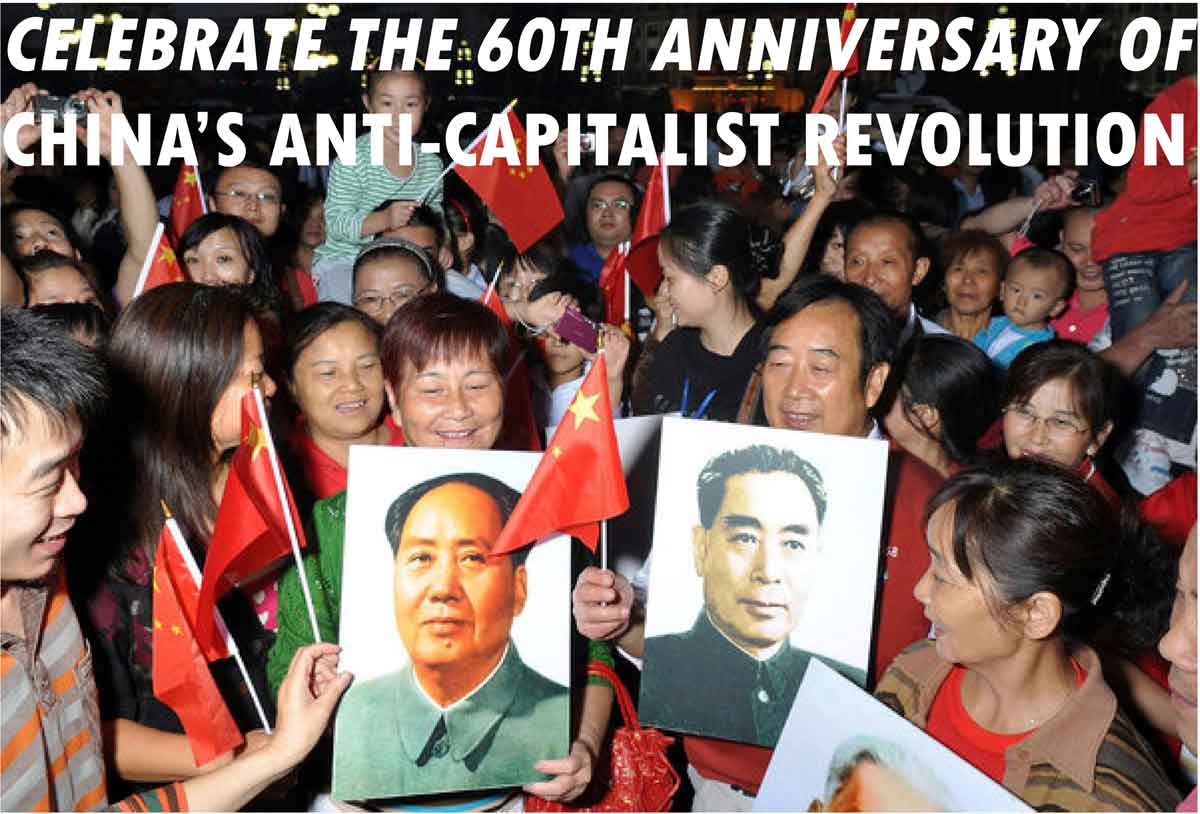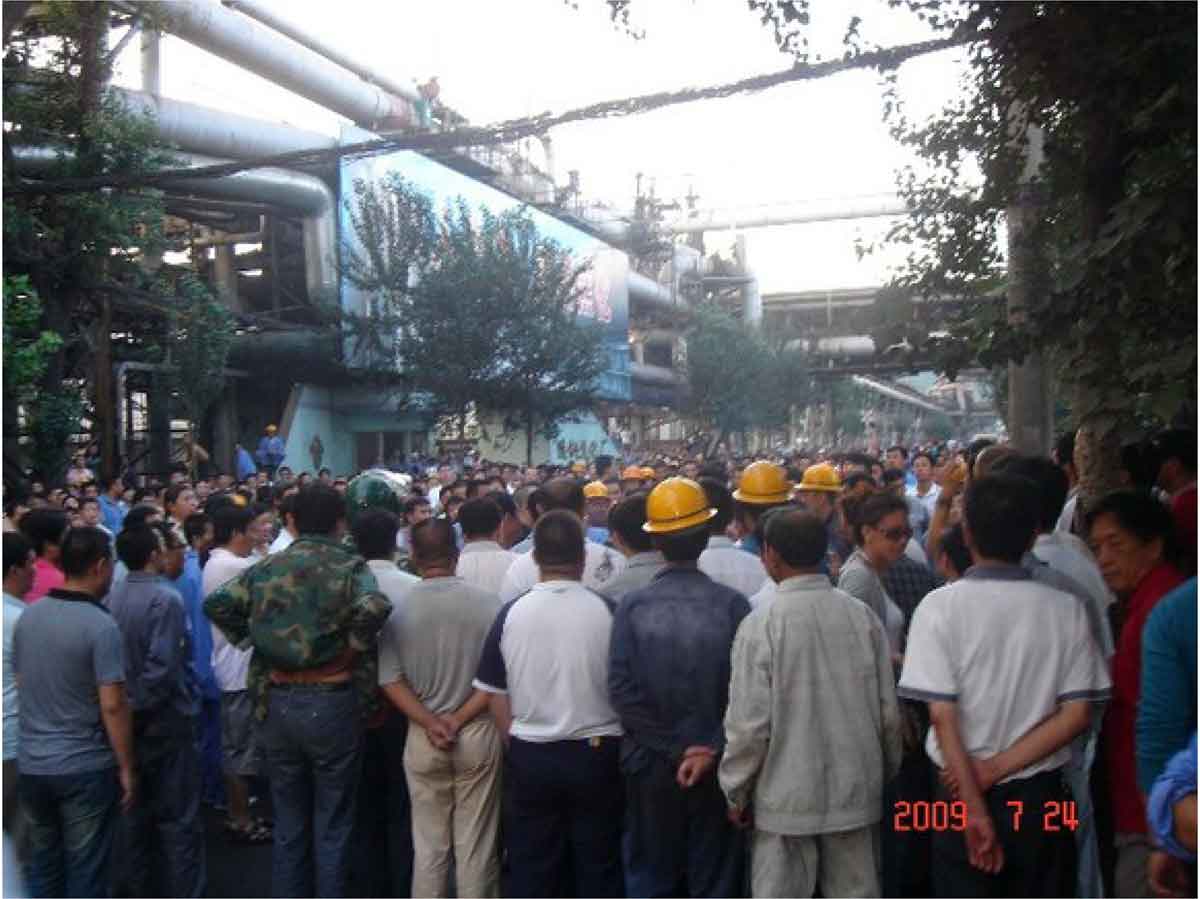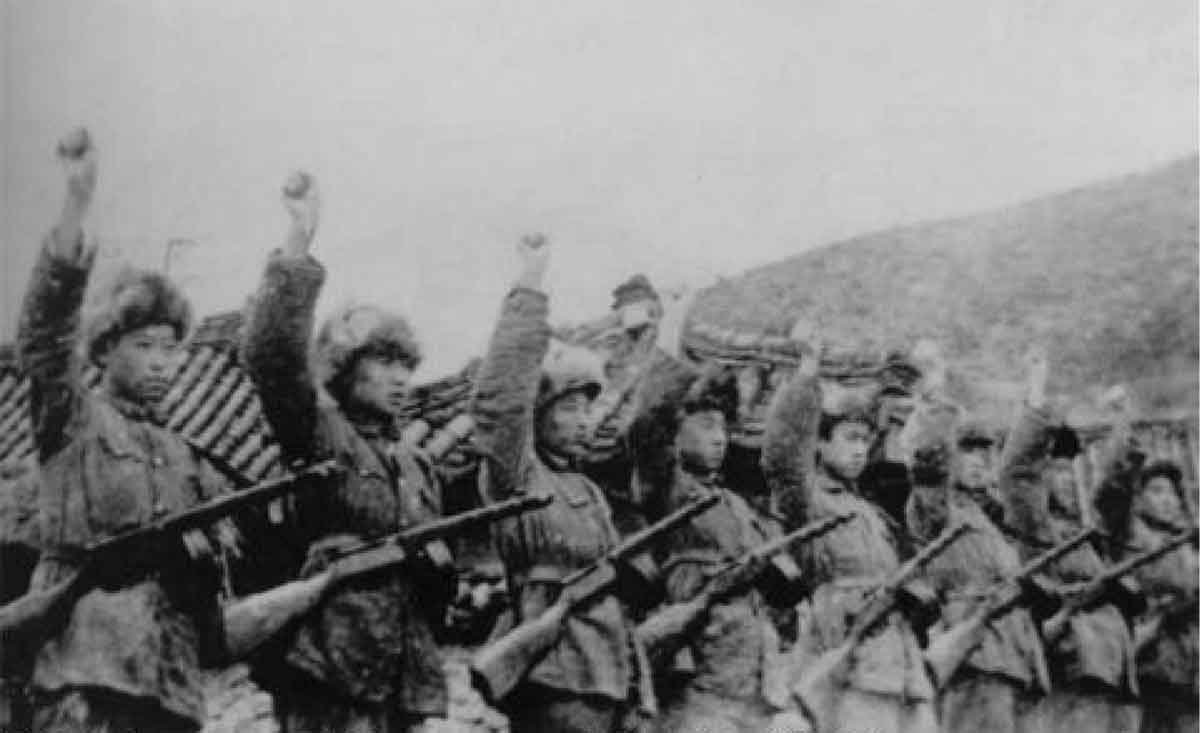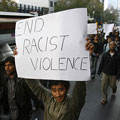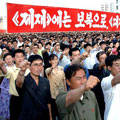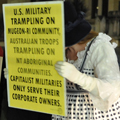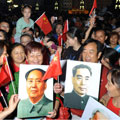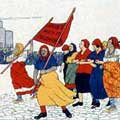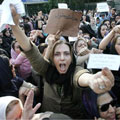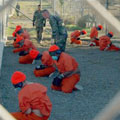China: People hold portraits of Mao Tse Tung (left) and Zhou Enlai at local events to celebrate the PRC’s 60th anniversary.
Sixty years ago, one of the most momentous events in humanity’s entire history took place. The long-suffering Chinese masses overthrew their exploiters and took power. They achieved this victory after a bitter three-year civil war. On one side of the war stood the downtrodden tenant farmers, workers, working-class women and idealistic students. They were organized by the Communist Party of China (CPC) which was led by Mao Tse Tung. On the other side were the brutal landlords and capitalists. These oppressor classes were served by the Kuomintang (KMT) government of Chiang Kai-Shek. The KMT was heavily armed, trained and advised by the U.S. But still they lost to the Communist-led revolutionaries.
Before the Chinese revolution the Chinese toilers and women were oppressed beyond belief. In the cities, urban workers were exploited by capitalists who used gangsters to crush any workers’ resistance. Much of the wealth produced by the Chinese workers was taken away by Western corporations. Until the revolutionary movement became strong in the years leading up to the final victory in 1949, you had a system called “extraterritoriality” in China. Under that system, in cities like Shanghai, there were whole industrial regions called “concessions” where Western imperialists were not only exempt from Chinese law but exercised direct military and legal power themselves. Thus you had not only the Chinese armed forces enforcing the subjugation of the workers but also armed British, American, French and Italian soldiers.
Especially in rural areas, most women were subject to forced marriages after which they were treated like slaves. They were rarely allowed to leave the home. A large proportion of Chinese women could not physically do so anyway because they were crippled through having their foot bound – a barbaric practice where the toe and foot bones of young girls were broken in order to constrict the feet into a cone shape for supposedly aesthetic reasons.
Before the anti-capitalist revolution, most of the Chinese population consisted of tenant farmers whose greater part of their produce was taken away by their landlords. As described by American journalist, Jack Belden, in his book China Shakes the World (a fascinating eyewitness account of the Chinese Revolution), the landlords control over the families of his tenants in those days was total:
A rich peasant or landlord merely had to wait until a farmer was in the fields and go around to his home and force the farmer’s wife to his wishes. Short of murder, which was difficult because of the landlord’s guards and because the landlord controlled most of the spears in the village, the farmer had no recourse, especially since the landlord or his henchman was village chief and hence the police power too….
However, awakened and given confidence by Mao’s CPC, the crushed tenant farmer arose to become the main force in the revolution. As described so eloquently in China Shakes the World:
For this simple man, born to tenant, feudal slavery, to an over-worked and crowded plot of ground, stunned into obedience beneath the grasping landlord’s hand, dispossessed from his land by crooked deals and savage violence, robbed of his wife’s caresses and his children’s laughter, suddenly rose with an impassioned thrill and, under the threat of death itself, began to demand land and revenge.
The rural poor flocked to the Communist’s Peoples Liberation Army and supporting mass associations. When these forces would take over a village from the Kuomintang, they would Overturn the village. As the term implies, they would literally turn the whole social structure of the village upside down. The land would be taken from the landlord and divided up between the tenant farmers. The landlords and their bailiff thugs would be paraded before Speak Bitterness meetings where the previously terrified tenants now boldly confronted their former oppressors with their crimes. Meanwhile, women with the Peoples Liberation Army behind them formed themselves into Women ‘s Associations to enforce women’s equality. The Overturn in power and economic relationships changed life for the rural poor in every way – previously they had been denied education, banned from public dancing and rarely had the chance for any artistic expression. Belden describes how in the Communists’ Liberated Areas theatre, for example, took off. He makes a point about one play he saw during the Civil War in the town of Pengcheng:
Until very recently in China, as in Shakespeare’s time, all women’s leads were generally played by men, but in Communist areas, female leads were generally played by women. And it was quite moving to see women with bound feet, who hitherto had not been allowed outside the home, toddling around the stage and acting out the part of an emancipated women.
As the Civil War between the two sides raged on, the control of some regions repeatedly changed hands. In formerly Communist-controlled areas that were seized back by the KMT, the KMT and landlords exacted murderous revenge on those who had participated in the earlier Overturning of the village. Often the KMT would publicly execute farmer activists. Those tenant farmers that participated in land reform that were not finished off by the KMT would often be buried alive by the landlords themselves. If the landlords could not find the tenant in question they would bury the farmer’s family – throwing women and children into ditches, pits and wells and covering them with earth. Such was the barbarity practiced by the exploiting classes in their desperate attempt to cling onto power. However, against them were arrayed tens upon tens of millions of Chinese people. There has never been a social movement in history that involved more direct participants. And through their unimagineable courage, these communist-led masses triumphed. On 1 October 1949, Mao declared the founding of the Peoples Republic of China. It was the toiling masses that were now in state power in China.
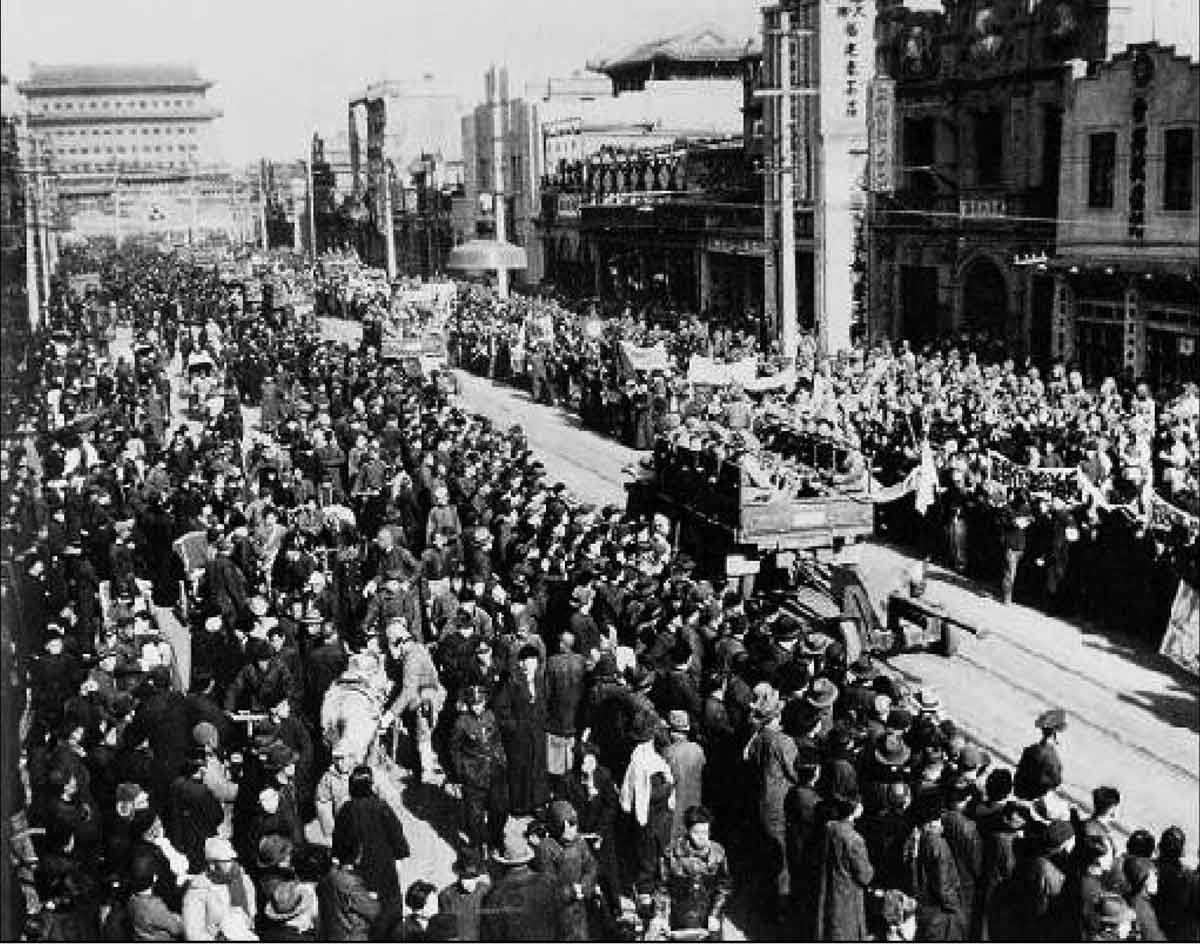
Beijing, 1949: Communists triumph. Masses line the streets to greet the victorious Peoples Liberation Army.
BRINGING INTO PLAY THE ADVANTAGES OF THE SOCIALIST SYSTEM
Unlike the 1917 Russian Revolution, which was spearheaded by urban wage workers, the main forces in the Chinese Revolution were poor tenant farmers and rural workers. What did this difference between these two great revolutions mean? Well, in Russia the urban working class that made the 1917 Revolution could truly be welded together so as to be unbreakable. Not only were the proletariat assembled together in large numbers in big factories but these
wage workers knew they’d make no economic headway unless they were united and thus collectively strong enough to extract a greater share of the fruits of their labour from the capitalist boss. To be sure, it still took the tireless efforts of a determined communist party to solidify the workers together. However, the point is that it was possible to unite the revolutionary class through its own organizations, the factory committees and
soviets, and it was these elected workers organizations that exercised power in a truly sovereign way immediately after the 1917 Revolution. This administration lasted in Soviet Russia for about seven years until the pressure of hostile encirclement by foreign powers led to a bureaucratic degeneration of the workers state (from that point on until its collapse in 1991-92, the USSR remained a workers state but its administration was no longer based on workers democracy.) Now, in China the poor farmers who were there the key revolutionary class also had to show great unity. Without this they could not have triumphed in the Civil War. However, because the tenant farmers worked as individuals (albeit handing a big chunk of their produce to their landlords) they operated separately from and even in direct market competition with each other. This mode of production inevitably had its reflection in the way the farmers related to each other. Thus, at times the tenant farmers had to be held together somewhat artificially
from above by the more politically aware communist cadres. During the Civil War the burning necessity to defeat the landlords kept the poor farmers together but afterwards, especially, the CPC cadres were required to smother centrifugal tendencies that would otherwise have torn the unity of the tenant farmers apart. As a result, unfortunately, the workers state produced by the 1949 Revolution was bureaucratically deformed from its very inception.
Despite this major deficiency, the Chinese Revolution was a tremendous step forward for Chinese workers, poor farmers, women and ethnic minorities. The revolution freed the tenant farmers from landlord tyranny. The Western imperialist oppressors were thrown off China’s back. And within a few years, the new revolutionary power ripped the key industries away from the capitalists and placed them into the collective hands of all the people. This new economy dominated by public ownership enabled China’s rapid industrial and social development. A public health system erected alongside the socialistic economy enabled China to achieve arguably the most spectacular feat in social progress of all time: the life expectancy of the world’s most populous country was nearly doubled in less than three decades from under 35 years at the time of the Revolution to over 67 years by 1978! Mass education campaigns have moved towards wiping out illiteracy. Meanwhile, the overthrow of the Han-chauvinist KMT regime allowed ethnic minorities to learn – and in some cases even revive the influence of - their own languages.
China is still overall not a rich country. It is pulling itself up from centuries of feudal-imposed backwardness and subjugation by Western colonial powers. However, under socialistic rule it has gone from being an impoverished neocolony to the being the third country in history to put a human in space. More recently the PRC became the country to most magnificently host the Olympic Games. And today, while most of the capitalist world has either suffered a deep recession or skirted on the edge of one, the PRC’s socialistic economy continues to surge forward. In the second quarter of this year the PRC economy grew at a rapid 7.9% year-on-year.
THE THREAT OF COUNTERREVOLUTION
It would be naive to think that the anti-capitalist gains in China do not face serious dangers. For the last 60 years, the world’s capitalist powers have sought to rollback the conquests of the Chinese Revolution. To this day the U.S. Navy provocatively sends its aircraft carrier fleets skimming near China’s waters. The U.S, Australia and Japan have a tripartite alliance that is primarily aimed against the PRC and its North Korean ally. For the first few decades of its existence the PRC faced economic sanctions and diplomatic isolation – in was not even allowed a seat in the UN until 1971! Under all this pressure, the CPC leadership made an opportunist - and ultimately self-harmful - alliance with U.S. imperialism in the early 1970s. The PRC sadly wound back the level of its support for the Vietnamese revolutionaries against imperialism and backed capitalist forces against the Soviet workers state in several regional conflicts. Later that decade, the PRC leadership headed by Deng Xiaoping moved to the right on domestic issues as well. They allowed
the development of a private sector under a “reform and opening up” policy. Although this policy has within limits contributed to economic development in some areas, overall it has led to greater inequality, increased corruption and at times even ethnic tensions.
Deng’s post-1978 reforms have inevitably somewhat corroded the public sector of the Chinese economy. Nevertheless, China’s productive land, pillar industries (such as transport, energy, communication etc) and major banks all still remain in the socialistic state’s hands. This has tremendous significance. For one it has enabled the current Hu Jintao government to decisively reverse the Deng/Jiang Zemin course which was heading towards an anti-egalitarian, “user pays” health care system and instead return back towards a universal public health system. In the first half of this year alone, the PRC started constructing 986 county-level public hospitals, 3,549 township public hospitals and 1,154 community health centres! Meanwhile, the arrest of many capitalist high-fliers on corruption charges – including China’s richest man Huang Guangyu and several Rio Tinto executives – is an indication of the fact that while some capitalists have got filthy rich, the capitalist class has not secured the guaranteed right to exploit in China, let alone captured state power. This is, of course, in sharp contrast to the situation for capitalists in Australia which is indeed in no sense a workers state! Here they are lauded by the bourgeois press (aka the Capitalist Public Relations Bureau) as heroes. And here they truly do rule the roost, strutting around the capitalist hen yard like roosters puffed up by their hired scribes’ assurances that it is they - with their well recompensed boardroom deliberations and share portfolio shufflings - and not the mostly undervalued labour of millions that is the true source of the wealth of nations.
Yet the post-1978 reforms have truly spawned a class of capitalist exploiters in China, a class that is nurtured at every level by its counterparts in North America, Europe, Taiwan, Singapore and Australia. The wealth of these private business bosses - and of the more numerous managers and high-flying professionals serving them – certainly brings with it some influence. There is today in China a layer of academics, economists, journalists and politicians promoting the interests of China’s capitalists. Such elements are to be found even within the CPC and governing departments. Consequently, there is an intense and multi-faceted factional struggle within the CPC between on the one hand the pro-capitalist right-wing and on the other hand those elements wanting to defend the socialistic character of the PRC. This dispute underlies almost every major question in Chinese political life.
Today, the right wing is deviously using the improved relations between the PRC and KMT-governed Taiwan to dilute the CPC’s differences with the capitalist KMT and thereby corrupt the Communist Party of China’s pro-socialist character. Meanwhile, the factions soft on capitalism have been on a campaign to deny the 1949 Revolution its deserved recognition as being the starting point of China’s economic successes. Instead they seek to credit everything to the 30 years of market reforms. That is why it is crucial that the 60th anniversary of the founding of the PRC be celebrated energetically and proudly. And it should be celebrated with a full understanding of its significance. Let us all remember that the PRC was founded through an anti-capitalist revolution and that this revolution was made through overthrowing the murdering Kuomintang regime.
Let it also be known to all that Taiwan’s economy was based on the huge stocks of gold that the Chinese capitalists had looted from the masses before they eventually fled to Taiwan as the 1949 Revolution swept the mainland. And that Taiwan’s economy was also built with massive U.S. aid to beef it up as a bulwark against the PRC. Then there is, of course, the brutal exploitation of Taiwan’s workers by its capitalists. Recently, Taiwan’s KMT rulers showed callous indifference to poor people stranded by Typhoon Morakot, many of whom were from indigenous communities. That is no surprise. In March 1947, the KMT then-rulers of China massacred between 5,000 to 20,000 of Taiwan’s people following an uprising on the island against their brutal and corrupt rule. It is about time that the Taiwanese working class and indigenous peoples are freed from the capitalists that oppress them. The 1949 Revolution must finally be extended to the island of Taiwan. That means reunification of China - but not on the basis of “One Country, Two Systems” but on the basis of One System of Socialistic Rule.
WHICH CAT IS CATCHING THE MICE?
Although Chinese rightists and the Western media always credit foreign investment for China’s economic achievements, one would have to be insane to try and credit foreign investment for China’s defiance of the current global recession. In the first half of this year, foreign investment into China was 20.3% lower than in the same period last year (
The Australian, 28 July) and in July foreign direct investment was a whopping 35.7% lower than a year earlier (
Xinhua, 18 August.) By contrast, state-owned enterprises increased their investment in the first half of this year by 22% year on year. It is this socialistic state sector that has enabled the Chinese economy to buck the global trend over the last year and a half. Not enslaved to market forces and the profit motive, the PRC state enterprises have moved to increase employment and activity in order to make up for job slashing by the private sector. Notably, too, China’s state-owned major banks have massively increased lending in order to spur on economic expansion and social programs. In the first six months of this year, China’s banks lent nearly 1.1 trillion U.S. dollars, exceeding the total for all of 2008 (
Time magazine, August 10.) To capitalist banks this would be lunacy during a global recession – especially when corporate profits are falling in China too. Indeed, Western banks have refused to lend much during the crisis. However, the PRC state banks were directed to copiously hand out loans for infrastructure projects not because it was good for their profits but because it was
good for the people, because it was what was necessary to ensure that China rode safely through the world recession.
The rescue job of the PRC economy that has been performed by its state-owned enterprises has the Western business media and Chinese pro-capitalist “experts” squealing. The burgeoning state sector is squeezing out the private sector, they say. State banks’ lending is going mainly to state-owned enterprises while private firms have a hard time getting loans. Comically, China’s private bosses even cry poor by labeling the state-owned firms as monopolies getting “favoured treatment” while they are supposedly the “little guy.” Yes, except this misses the key point: in the PRC’s state-owned giants any profits made go back to all the people in the form of public health/education/transport expenditure or as investment in socially necessary new plants and equipment while in the private enterprises most of the profits go back only to the avaricious owners. To this sorry sobbing by the private business owners, we should respond by recalling here a quote from Deng Xiaoping that they had previously long used to advance their agenda. Deng remarked in response to questions about whether certain economic methods were socialist or capitalist: It does not matter whether a cat is black or white, if a cat catches mice then it is a good cat. Deng’s analogy which was used to justify pro-market economic reforms as long as they (supposedly) produced growth was flawed: if one type of “cat” (the capitalist one) was, as well as catching mice, also stealing the food of the other mice-catching cats and was spreading disease then it was not such a “good cat” after all. Nevertheless, Deng’s quote should today be thrown back in the faces of advocates for the private sector: since it is the state-owned enterprises that have proved capable of catching the mice and thus saving China from the global economic collapse, these are the “good cats” that should be fed the best food.
Unfortunately, although it is economically rational to ignore the demands of the private bosses’ lobby groups - like the All China Federation of Industry and Commerce - the incessant howls of this layer has won them concessions. Premier Wen Jiabao has called for more bank credit to go to private firms or to Small and Medium Sized Enterprises (SMEs) which in China is often a codeword for private enterprises. Meanwhile, some partial privatization of minority stakes in state-owned enterprises continues. In July, a minority of China’s largest home builder - the China State Construction Engineering Corporation (China Construction) - was sold off.
Jilin Province, China, 24 July 2009: Militant street and factory occupation by thousands of steel workers. Workers action smashed attempt to privatise the Tonghua Iron and Steel Group. Working class is the social force that can both defend China’s socialist property and root out corruption and bureaucratism.
THE WORKING CLASS CAN KEEP CHINA ON A SOCIALIST PATH
The only social force that can really defeat the pro-capitalist groupings is the working class. Already over the last twenty years or so it has been workers’ sentiments and struggles that have rebuffed more wholesale privatizations and deterred certain right-wing moves. This stance by Chinese workers has won over, or at least constrained, a chunk of the PRC bureaucracy to try (to a greater or lesser degree) to satisfy workers’ demands. On July 24, workers in northeastern Jilin province spectacularly smashed what would have been one of the largest full-scale privatizations in China in years. This proposed privatization involved the takeover of state-owned Tonghua Iron & Steel Group by privately owned Jianlong Heavy Machinery Group. However, when the new general manager appointed by the private firm, Chen Guojin, met Tonghua managers on the morning of July 24, workers began gathering outside. They were furious at what they understood was a peoples owned company being turned over into private ownership and were angry that the new capitalist owners planned huge layoffs. Around 5pm, thousands of workers stormed the factory to stop the production line and beat the greedy manager Chen Guojin. Masses of workers blocked roads to stop ambulances and police from reaching the injured private boss. By 9pm the government had publicly announced that the privatization had been cancelled. Although medical staff were later able to reach the injured executive it was too late to save his life.
The impact of the Tonghua steel workers’ struggle reverberated within the halls of Chinese government and officialdom. State media, instead of denouncing the Tonghua workers, gave them semi-supportive coverage, highlighting workers’ anger at planned job cuts and sympathizing with their outrage at the fact that Chen was being paid an exorbitant annual salary of 3 million yuan ($A526,000) while planning savage job, wage and pension cuts.
What was apparent in the Tonghua struggle was the degree of workers’ understanding that in the PRC state industry belongs to them whereas private industry belongs to exploiters. Typical of the attitude to private firms was that of retired Tonghua worker (in many state-owned firms including Tonghua, workers are paid pensions by the state enterprise itself) Zhang Guanghui who expressed his revulsion at the corporate raiding private firm Jianlong: “Why should we let such a private firm to take control of us” (Xinhua, 28 July, emphasis added.) Xinhua news agency described how Wang Xidong, deputy head of the Jilin Provincial State-owned Asset Commission saw Tonghua workers’ attitudes to the issue of state versus private ownership:
… workers from state-owned firms, especially retired workers had believed that state-owned firms are ‘iron rice bowls’ that can guarantee lifelong employment and secure pay, even after retirement. They opposed the merger, which would allow a private firm to disillusion their dream ….
Just weeks after the Tonghua struggle, workers at the Linzhou Steel Company in Henan Province smashed an attempt to sell off their state-owned firm to privately owned Fengbao Company. On the way to their victory, workers took hostage the assets-control state official managing the privatization.
Workplace victories for Chinese workers, like the ones at Linzhou and Tonghua, are crucial and powerful. However, they need to be combined with an overall program for strengthening the socialistic sector. The type of demands that Chinese workers and pro-communist intellectuals should raise include:
- Stop all partial (and of course all full) privatizations of state-owned enterprises. In particular, scrap the plan to sell off a minority stake in the Agricultural Bank of China, China’s fourth largest state-owned commercial bank.
- All private firms that violate safety regulations or break China’s new pro-worker, Labour Contract Law to be immediately nationalized without compensation.
- Build the finances for state infrastructure development and state industry modernization! Right-wing economists claim that the government cannot continuously go into debt to finance such projects. True, that is why there should be higher taxation of the rich and the introduction of a steep capital gains tax on share trading and property transfers in order to provide resources for the state projects.
- All former state-owned enterprises that were illegally or semi-legally privatized in the late 1990s-early 2000s through management buyouts or fire sale purchases by government officials to be immediately nationalized without compensation.
To be victorious in these struggles to defend the socialistic economic sector requires curbing the political influence of the capitalist class. Today, pro-capitalist forces in China are deviously attempting to multiply their political influence by advocating a form of “democracy” like that practiced in Western capitalist countries. Such calls for Western-style “democracy” have not only been made by open counterrevolutionaries like the Charter 08 group of lawyers and academics but have also been alluded to by rightist figures within the mainstream. The latter include retired vice-president of the People’s University, Xie Tao and by Mao’s one time secretary, Li Rui. Even Premier Wen Jiabao, while not going so far, has at times spoken about the virtues of “democracy” in the abstract while dangerously neglecting to specify if he meant workers democracy or capitalist democracy.
However, as long as there are economic inequalities in society, a Western-style “democratic” system in which all individuals nominally have “equal rights” will inevitably become a system dominated by the rich classes. For it will be the rich who, disproportionately to their numbers, have the money to fund political parties, pay for political advertising and sponsor political/semi-political NGOs and “independent think tanks” to promote their class interests. Although China’s media and publishing industries are currently in state hands, the granting of greater political “freedom” to the capitalist class would see them quickly use their resources to campaign for the privatisation of the media under the guise of the need for an “independent” press. Then the media, publishing, film industry and other creators of public opinion will all be transferred into the hands of rich tycoons - who would naturally use these instruments to promote their goal of privatizing China’s core state-owned enterprises.
In the meantime, if the organs of the Chinese state are transformed from explicitly pro-working class, pro-communist instruments into Western-style “democratic” bodies that serve all classes “equally” then they too will rapidly fall into the hands of the capitalist class. As they will no longer be held fast by ideological training and commitment to serving the toilers, the upper ranks of the army, police, courts and bureaucracy will develop a natural affinity and social connection with the top echelons of the capitalist business circles. The army top brass, judges and police chiefs will start to share membership of the same exclusive clubs and start attending the same conferences as the capitalist high fliers. The ties between the capitalists on the one hand and the top state officials on the other would be further cemented by mutual attendance at each others’ house parties and eventually through their sons and daughters marrying each other. Furthermore, no longer bound by a duty to specially serve the working class masses, the state personnel would be even more likely to take, and get away with taking, bribes from rich private businessmen.The army officers, moreover, having been broken off from the pro-toilers traditions of the Peoples Liberation Army will more easily make connections with other “non-political, national armies” around the world – i.e. other capitalist armies. Exchanges with capitalist militaries would multiply and the Chinese military top brass would seek to emulate their counterparts abroad, especially those in the most powerful “non-political, national” army in the world: the U.S. military. Eventually, the Chinese military would become just like their counterparts in the capitalist world – an army serving the exclusive interests of the rich classes. Engagement in imperialist escapades such as the current criminal campaigns in Iraq and Afghanistan would, no doubt, likely ensue.
A similar course would be travelled by the Chinese judiciary, prosecutors, police etc. To be sure there would be many proudly pro-working class army officers, judges and police heads who would resent such a course. They would resign from the newly “democratic” institutions or get purged. This however would only speed up the transformation of the institutions that they formally led. In short, the implementation of Western style “democracy” would see the Chinese state transformed from a workers state to a state for the capitalists and the power in society would be transferred from the toiling masses (in however a tenuous manner it is currently held by them) to the rich classes. China’s pro-capitalist forces and their Western advisers know this all too well, which is precisely why they promote Western-style “democracy.”
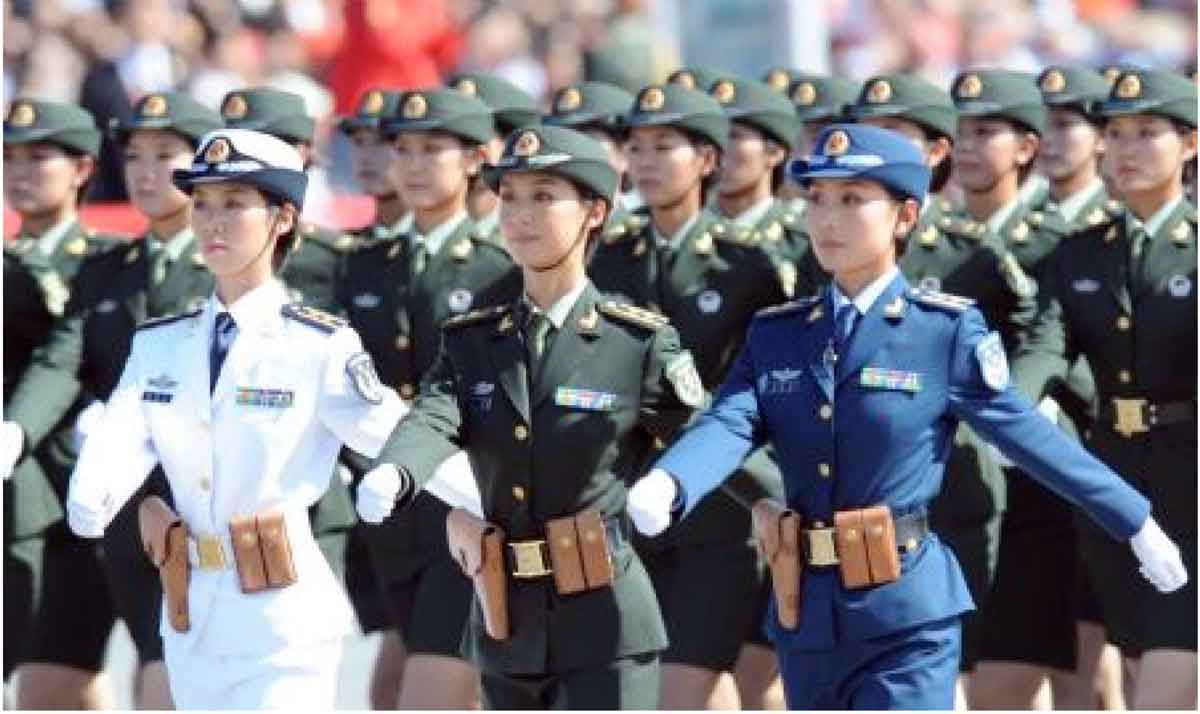
Beijing: Female officers and soldiers of the Peoples Liberation Army march in the parade to mark the 60th anniversary of the founding of the PRC. China’s anti-capitalist revolution led to a big leap upwards in the status of women.
To combat these attempts by capitalists to prepare for a future power grab, China’s pro-socialist forces should fight for the following:
- For all capitalists, that is all private enterprise owners using hired labour, to be barred from being legislators in China’s national and local peoples congresses (parliaments).
- For all legislators and government officials to be banned from holding shares in any company.
- Absolutely maintain the Peoples Liberation Army (PLA), peoples courts and Chinese police as explicitly pro-working class peoples institutions! Strengthen the pro-socialist ideological character of the PLA, courts and police! Do not taint the PLA through military exchanges with capitalist armies or joint exercises with them such as occurred in 2007 with the Pacific Islands-marauding Australian and New Zealand navies. Withdraw the PLA from all joint international “peacekeeping” operations that include imperialist militaries.
- Counterpoise calls for Western-style democracy by moving towards explicitly workers democracy – where the state power of the toiling classes is administered through elected councils of workers, poor farmers and PLA soldiers. Capitalists would be excluded from these organizations but all political tendencies that support working class rule and a socialist-owned economy would be able to participate with full freedom of criticism.
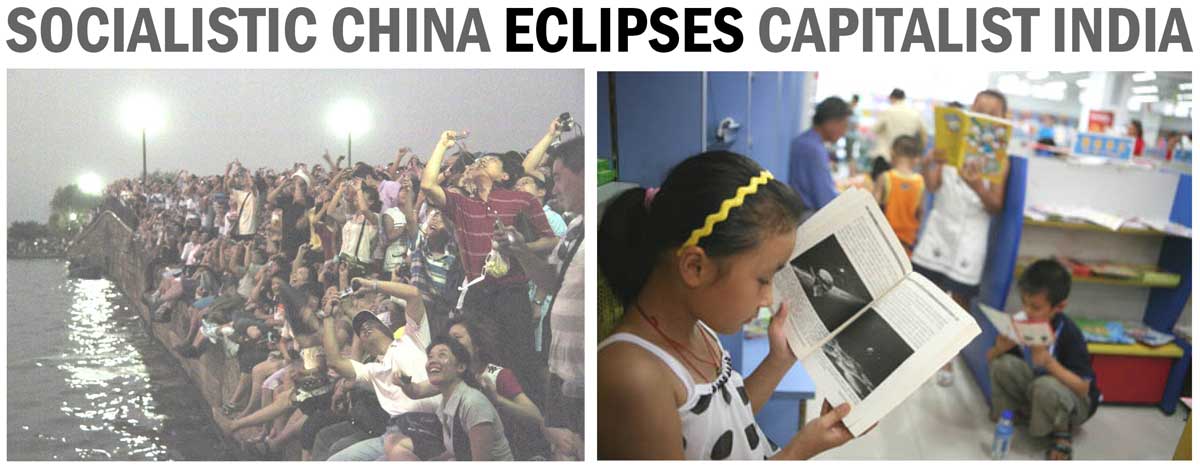
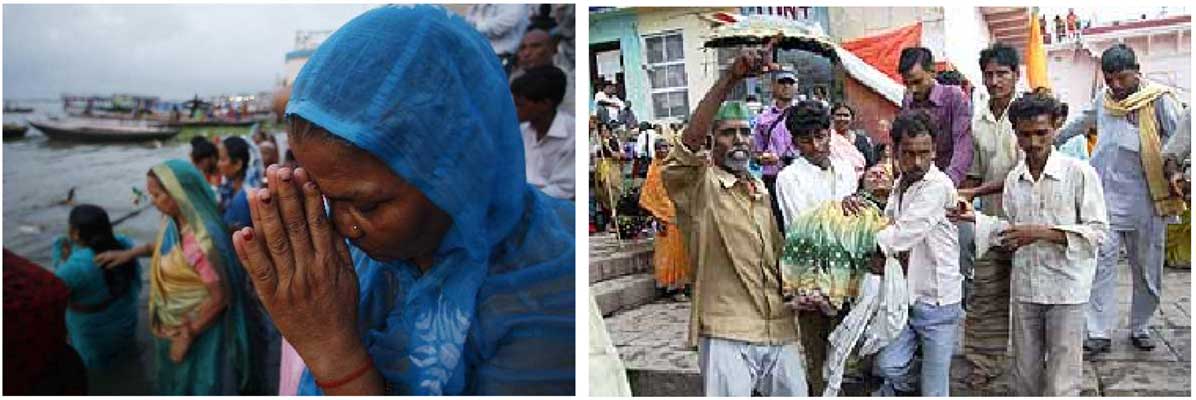
THE CHINESE REVOLUTION WILL ONLY BE SECURE
WHEN ANTI-CAPITALIST REVOLUTIONS TRIUMPH GLOBALLY
The danger faced by the Chinese Revolution is especially great because of the massive support that counterrevolutionary forces in China receive from the capitalist classes that rule most of the world. All the various anti-communist groups – from pro-Western “democrats” to Falun Gong to Rebiya Kadeer’s World Uyghur Congress to the Dalai Lama’s forces – receive funding and technical/tactical assistance from U.S. government agencies. Meanwhile, imperialist military pressure against the PRC and the constant political attacks against her are all designed to bolster more right-wing factions within China - both those outside and within the CPC mainstream. These factions seize on anti-PRC hostility around the world to argue that only if China adapts more to the capitalist system can she ease the pressure bearing down upon her.
The capitalist powers seek to undermine socialistic rule within China even in those moments when they speak of building a “constructive relationship” with China. Take, for example, the results of the much heralded U.S.-China Strategic and Economic Dialogue held in Washington in late July. Part of the outcome of the talks was that China would move to allow more private investment into her hitherto state-dominated services industries and make small steps towards a more market-oriented financial system. Now, why would China want to make even the most modest steps towards the kind of financial system that has brought the capitalist world to a financial crisis and a deep recession? Especially when the PRC’s own state-owned financial system has held up like a rock! Yet the U.S. capitalists miss no opportunity to try and use the bait of “better relations” to hook the PRC onto a pro-capitalist path.
In the long run imperialism’s drive to knock down the PRC’s socialistic foundations will only be defeated when the capitalist rulers are toppled from power by socialist revolutions in their own countries. The required self-defence policy that the PRC should therefore take is to use its resources to campaign for a socialist transformation throughout the world. However, the conservative PRC leadership seeks instead to placate the capitalist powers by promising not to advocate class struggle in the West. To be sure, the reality of heading a workers state sometimes compels the PRC leaders to take a worthy stand against imperialism. Take, for instance, China’s vow to oppose any imperialist military intervention against socialistic Cuba. In general, however, Beijing bends over backwards to avoid disputes with the imperialist powers. Beijing follows a foreign policy that it calls mutual “non-interference in the internal affairs of other countries.” The vain hope being that if the PRC does not interfere in the affairs of capitalist countries then the capitalist countries will reciprocate and not interfere in China’s “internal affairs.”
Now the Beijing bureaucracy does sincerely believe in this policy and to the extent that it is actually possible to not “interfere in the internal affairs of other countries,” it actually tries to live up to its word. However, let us look at how successful the policy is. Firstly, consider the PRC’s relations with the richer of the capitalist countries – the imperialist powers. Sticking by its policy, the PRC does not take a stand on any internal question in those countries that is not very directly connected to China. Thus, the PRC provides little political assistance to the struggles of the working class and oppressed in the West and Japan. However, this does not stop the capitalist powers from interfering in China’s internal affairs. On the contrary they do everything they can get away with to foment capitalist counterrevolution in China!
Revolutionary forces in Jinzhou, 1948.
When it comes to China’s relations with many “Third World” capitalist countries the situation is slightly more complex. Many of these countries do not have the capacity to directly intervene in China’s internal affairs even if they wanted to. Of course, those poorer capitalist countries that are most closely aligned with imperialism do sometimes chime in behind anti-PRC, anti-communist campaigns. However, there are many “Third World” capitalist countries that instead maintain good relations with the PRC. Why? For the simple reason that they can pursue economic cooperation with China without having to be subject to the neocolonial exploitation that accompanies their dealings with the West and Japan. Thus these countries naturally choose not to interfere in the PRC’s internal affairs. In return the PRC, which desperately seeks friends in the outside world, provides economic aid to these countries without strings attached and without the patronising demands that Western powers always make. Especially in Africa and Latin America, this PRC assistance is providing genuine economic benefits to developing countries. It is also enabling these countries to be in a better position to resist the West’s typical insistence that they privatize state utilities and cut social service programs.
However, this PRC economic support of friendly, “Third World” capitalist countries can also at times come off as political support for the governments currently in power in these countries. In which case, it is “interference in the internal affairs of other countries.” This is especially problematic when the governing regime in a PRC “friend” is one that is fighting against a just opposition movement. Such was the case in Sri Lanka where the capitalist rulers fought a murderous war against the oppressed Tamil minority. Although China’s military role in this conflict was greatly beat up by the Western media (it was the U.S., Britain and capitalist Russia that provided the Sri Lankan forces with crucial military training, India that gave Colombo the decisive military intelligence and the West that hamstrung the Tamil fighters by cutting off their funding sources and slapping them with the “terrorist” tag) China’s economic support for Sri Lanka in this time of conflict – including beginning to build a civilian harbour facility in the city of Hambantota for completion in 2012 – could only have given the brutal Lankan regime comfort. Furthermore, following the lead of its socialist sister Cuba, the PRC (and indeed most of the “Third World”) went further and gave diplomatic protection to the Colombo regime against even the most token statements critical of their bloody anti-Tamil assault. In this case, the PRC’s – and indeed Cuba and Vietnam’s - policy of backing “non-interfering” Third World governments truly meant “interfering” against the interests of the oppressed. Apart from being totally counter to the spirit of the 1949 Revolution, this policy will in such cases only serve to give the PRC and Cuba a bad name among fighters for the downtrodden.
The policy of backing “friendly” Third World capitalist governments can in any case badly backfire on the PRC. For, in the end, the “Third World” capitalist regimes are subordinate to world imperialism and given the right prodding can easily turn around and actively become part of the imperialist-led drive against the PRC. Colombo, for example, seems quite willing to allow India to play a greater role in Sri Lanka – the very Indian state that is more and more acting as Washington and London’s deputy sheriff in South Asia. In the end, the PRC’s mutually beneficial economic relationships and development aid to “Third World” capitalist countries can only have an unambiguously progressive significance if it is combined with support for the struggles of the exploited and oppressed peoples of these countries.
In summary, Beijing’s policy of “mutual non-interference in the internal affairs of other countries” not only means the PRC turning its back on downtrodden people around the world struggling for their liberation but it is simply a policy that does not work. This is doubly so when it comes to China’s relations with the powerful imperialist countries. Trying to get imperialist states and workers states to amicably coexist is like trying to get a cobra and mongoose to peacefully coexist on a tiny patch of land. For the capitalist states and socialistic states are by their very nature counterposed – just as it is in the nature of both the cobra and mongoose to try and kill each other. If the mongoose has a muzzle put around its mouth that is not going to stop its enemy the cobra from killing and devouring it. Similarly, if a socialistic state decides to hold back from encouraging class struggle against the capitalist rulers abroad that does not stop the capitalist rulers from trying to foment capitalist counterrevolution in the socialistic country. That is why the only pragmatic policy for the PRC to follow is to “interfere in the internal affairs” of the capitalist countries by solidarising with the struggles of the exploited masses in those countries.
A common rebuttal to the advocacy of such an internationalist policy is that: only the masses inside a country can achieve their own liberation, it cannot be won for them from abroad. This is of course true. But that does not mean that support from abroad cannot have an important and even decisive impact. The Chinese Revolution in 1949 was itself greatly assisted by the USSR despite the fact that the leadership of that deformed workers state also more often than not shied away from a truly internationalist perspective. This was achieved not only through direct assistance to the Chinese revolutionaries but due to the fact that the very existence of the neighbouring and powerful Soviet workers state acted as a deterrent against direct intervention by the United States. In addition to this, the PRC owes a lot to its smaller neighbor to the east as the Korean Communist Party also provided much critical support to the Chinese Revolution. But let’s return to consider today’s reality. For nearly two decades the capitalist rulers have bombarded their populations with the lie that “Communism does not work.” However, today, while the capitalist economies implode even the biased capitalist media cannot hide that China’s economy is continuing to storm forward. If PRC leaders were to explain to the world’s masses that this unique success is because of China’s socialistic system, disgruntled workers in the West would much more readily see socialism as an alternative. Yet because PRC leaders make no effort to argue this outside of China, the capitalist media is able to obscure this important truth from the toilers of the world. Instead, the capitalist media is able to get away with confusing the masses with suggestions that China’s economic achievements are due to a supposed “growing embrace of capitalism.”
The foreign policy that the PRC truly needs to implement would include the following:
- PRC leaders to assert in international forums (and Chinese state media to proclaim) that China’s success in overcoming the global economic collapse is due to the socialistic character of its economy.
- PRC to much more strongly defend her socialistic sister North Korea. China to demand that all U.S troops get out of South Korea and to support North Korea’s right to defend itself from the imperialist threat by any means necessary – including by acquiring a nuclear deterrent.
- Growth in PRC-Cuba cooperation is very welcome. For PRC economic support for Cuba to be increased much more quickly.
- For the PRC to demand the immediate and unconditional withdrawal of all U.S./NATO/Australian troops from Afghanistan.
- The PRC should state its solidarity with the exploited and oppressed in the capitalist countries – including, for example, calling for the abolition of the anti-union Australian Building and Construction Commission and demanding the ending of the racist Northern Territory “Intervention” into Aboriginal communities.
- Currently in neighbouring Nepal, the revolutionary movement has much strength but is hampered by a fear that should the toilers seize state power they would be crushed by U.S./Indian capitalist intervention. Therefore, the PRC must make clear now that they would strongly back a future revolutionary state in Nepal.
- For China’s pro-CPC trade unions to support major strikes in the capitalist countries. This includes by, when possible, refusing to handle scab-made goods and initiating secondary strikes against the Chinese operations of struck companies.
If the CPC were to stand on such an internationalist program, they would find the most politically aware toilers and leftists all over the globe flocking behind the banner of support for the PRC. However, for this internationalist program to become popular enough in the PRC to be implemented, it will require a change in the outlook of Chinese communists. Today, even the most left wing elements in the CPC base their politics on what they see is best for China’s national interests or at best the interests of socialism in China. They need to, however, take their starting point on what is best for the struggle for world socialism - of which the battle to build socialism in China is, of course, a key component. When the CPC was first formed in 1921, its founding cadre keenly understood that a final triumph of socialism in China could come only as part of the fight for world socialist revolution. Today’s Chinese communists need to return to the internationalist perspective that animated the CPC when it was first formed and emulate its intense commitment to the principles of Marxism and Leninism, the principles that achieved the 1917 Russian Revolution. To do this, Chinese communists will have to totally free their minds from the grip of Chinese nationalism.
AUSTRALIAN SOCIALIST MOVEMENT MUST DEFEND THE GAINS OF CHINA’S 1949 REVOLUTION
The top priority for the work of Australian socialists is not what we think should be done by Chinese communists but what can be done
right here to help defend the conquests of the 1949 anti-capitalist revolution. This revolution was not only a giant step forward for the Chinese masses but a great victory for all the exploited and downtrodden people of this planet. The continued existence of a socialistic state, whatever its deformations, in a country that holds one in five of the world’s people – and one that is successfully dragging its population out of the terrible poverty and servitude of the pre-revolutionary days – presents a potentially powerful beacon of hope for all around the world who strive to stand against the ravages of capitalism. That is why leftists worldwide must counter all the propaganda obscuring the socialistic character of China’s development and must proudly proclaim that the PRC remains a workers state despite certain pro-capitalist concessions. Most importantly, the socialist movement in the West must blunt all the daggers that imperialism has lined up against the socialistic heart of the PRC. What is needed in Australia are protest actions to oppose the anti-PRC U.S./Australia/Japan military alliance, to oppose Canberra’s and the Liberal/Labor/Greens politicians’ encouragement for counterrevolutionary exile forces like Rebiya Kadeer’s group and Falun Gong and to solidarise with key pro-working class acts by the PRC state – like the recent crackdown on the erosion of socially-owned assets by Rio Tinto corporate thugs.
Although we are a new group of currently tiny size, Trotskyist Platform (TP) is proud of the work that we have done to popularize the need to defend the PRC workers state. For example, in late 2006 we organized a demonstration outside the Sydney headquarters of the Carlyle Group in solidarity with the (ultimately successful) campaign by Chinese leftists to stop the Carlyle-led privatisation of PRC state-owned firm, Xugong Construction Machinery. Today, TP stands ready to join with other genuine leftists, including the many pro-PRC socialists within migrant communities, to build a united-front, pro-PRC movement. Given the depth of anti-PRC propaganda in Australia and the current capitulation of much of the Australian left to this media barrage, we know that building a pro-PRC movement will not be easy. However, we know too that when Australian working class people inevitably break out into major class struggles against the capitalists here, they will be much more easily convinced of the necessity of defending the PRC. For after all, the PRC is that state that was born from a decisive class struggle victory in the world’s most populous country.
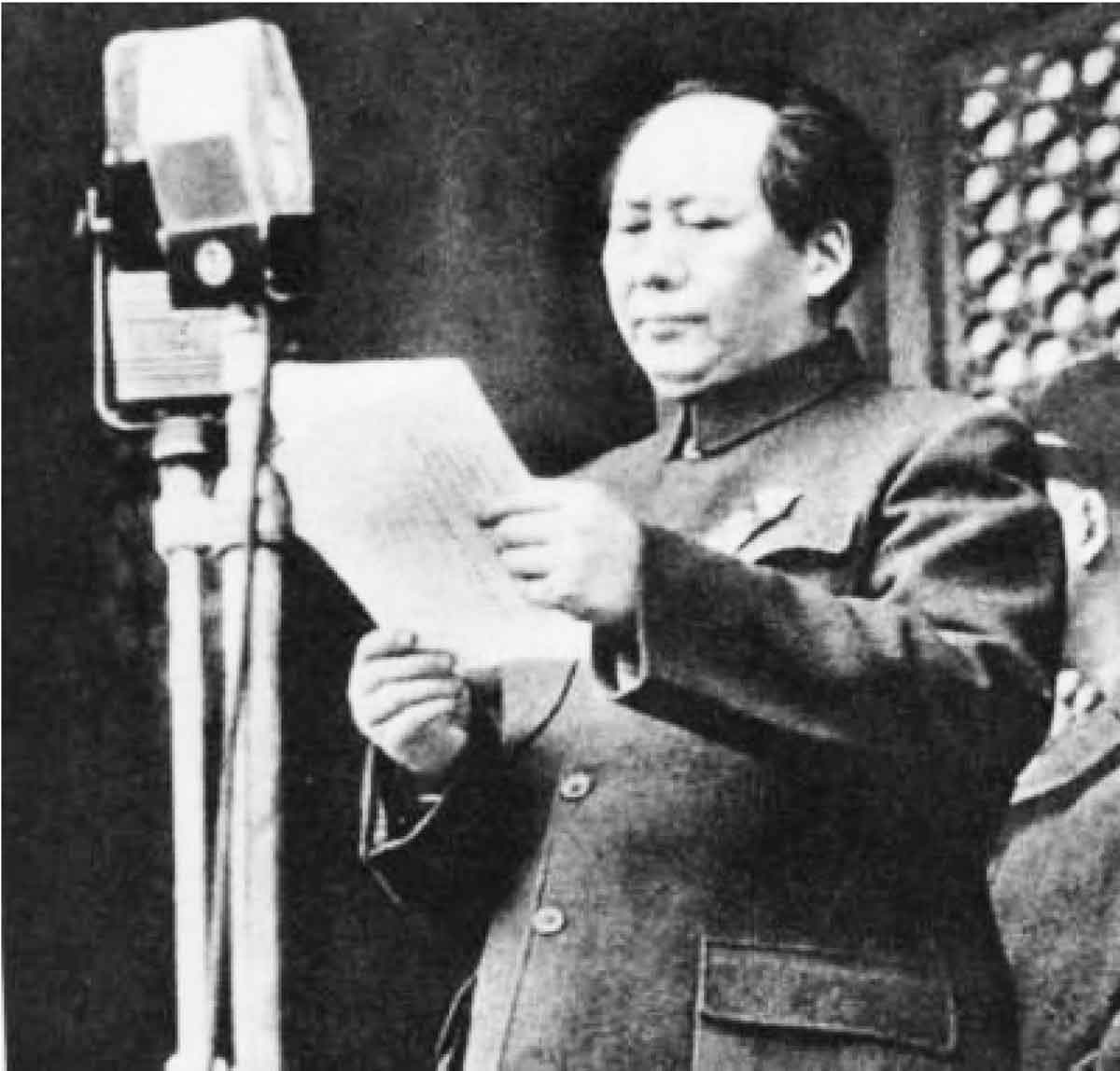
Beijing, 1 October, 1949: Mao Tse Tung famously proclaims the founding of the Peoples Republic of China before a huge crowd.
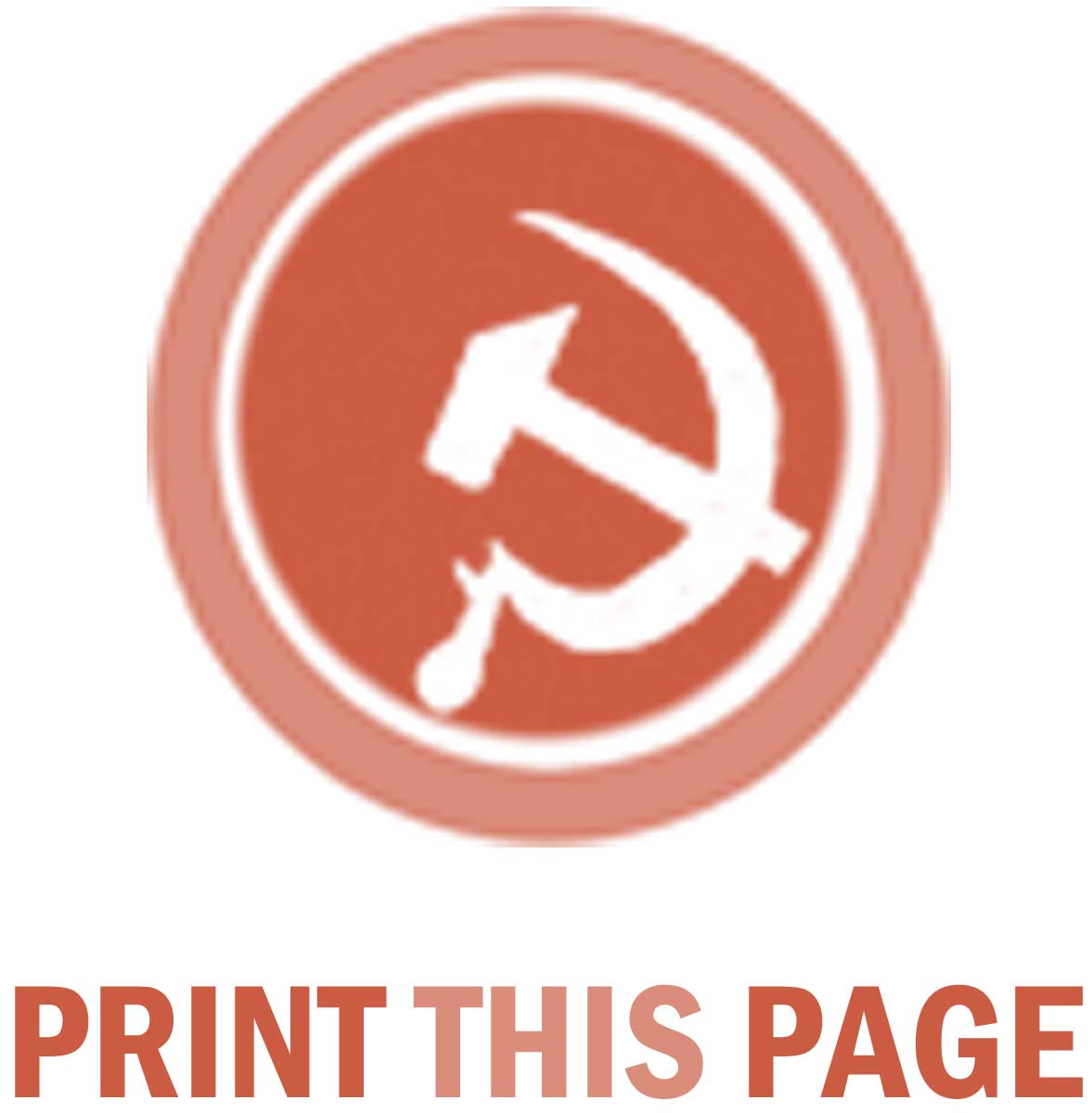
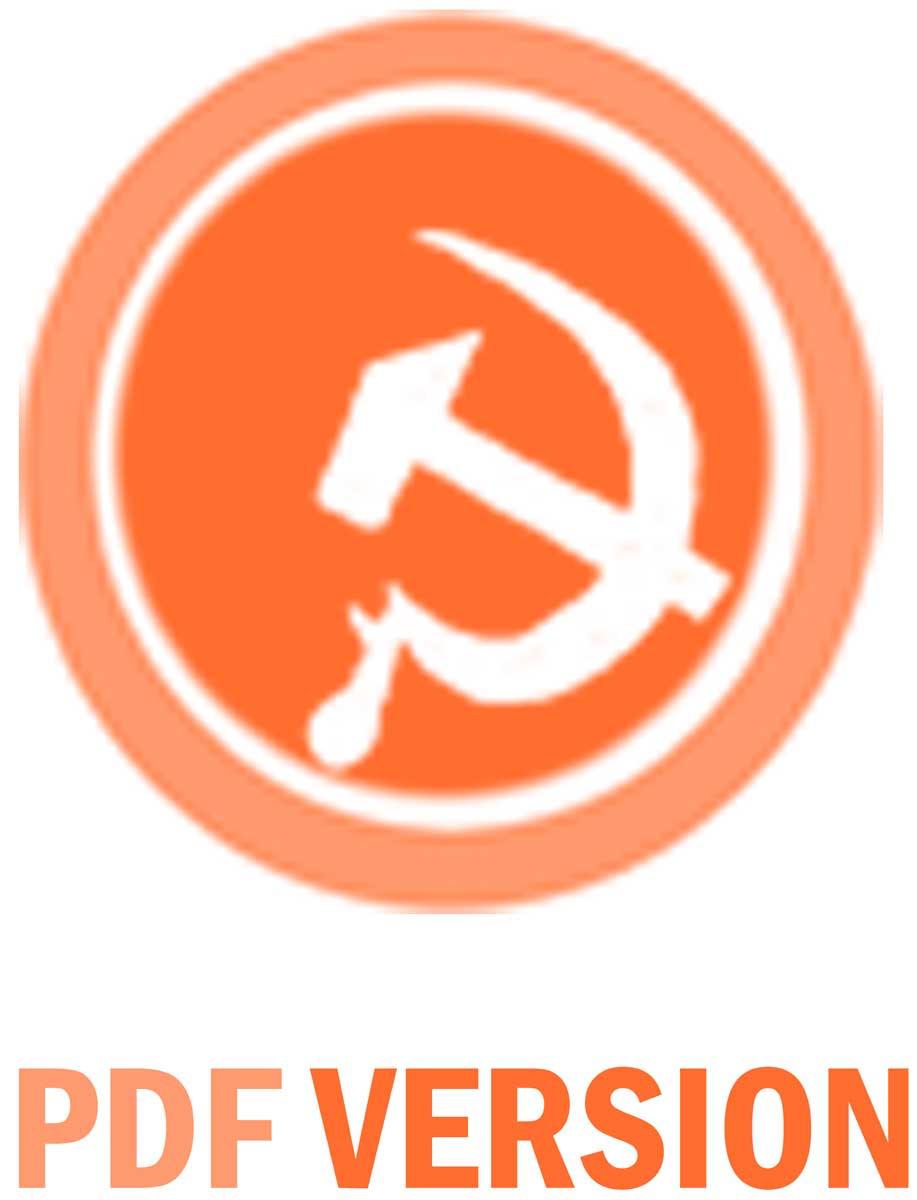
Trotskyist Platform: PO Box 1101, Fairfield NSW 1860, Australia.
E-mail: trotskyistplatform@gmail.com
Phone (Australia): 0417 204 611
Phone (International):0061 417 204 611
